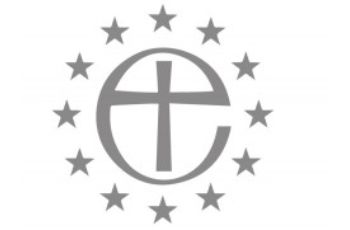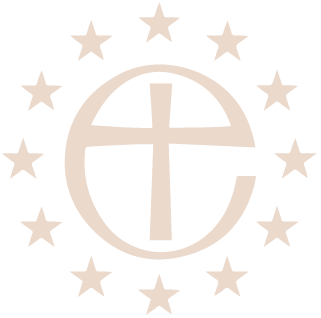
Sermon for the 7th Sunday of Easter, 1st June 2025: Readings: Acts 7, 55-6-; Rev 22, 12-14, 16-17, 20; John 17, 20-end.
Revd. Canon Leonard Doolan – St Paul’s Athens
At this time of year, where would we be without the evangelist, St. Luke? If we did not have his account of the days
after the Resurrection of Christ we would probably not invent the forty day period from the Day of Resurrection
until the Ascension of our Lord into heaven, not the period of a full fifty days until the promised coming of the Holy
Spirit at Pentecost. We are all the richer as Christians for St. Luke’s artistic and pictorial descriptions of these
mysteries.
Before the eyes of the apostles the risen Jesus disappears into a cloud and they stand there gazing upwards –
speechless, no doubt as this event happens before their eyes. Maybe they are thinking – ‘take me with you. I want
to go with you!’
Rather abruptly a divine messenger drags them back to earth. What are you gazing at up there? You will
experience him again here. What did he tell you? He said the Holy Spirit will be sent. He promised you this.
And so they waited. It is a strange period this, between Ascension until Pentecost. I would suggest that it is a sort
of parallel to the season of Advent. We find ourselves in the epoch of expectation and anticipation – almost like
the Apostles are back in that time when the ‘people walked in darkness’ waiting for the light of the Messiah. We
place ourselves again as participants of those parables Jesus told about the arrival of the Bridegroom – get
yourselves ready! Be prepared! Blessed is he who comes in the name of the Lord, as we say in our Liturgy.
We get a hint of this image in the reading from the Apocalypse today, ‘the Spirit and the Bride say, “Come Lord
Jesus”’. The bride, Christ’s Holy Church, awaits the fulfilment of the presence of her divine Bridegroom – the
Advent Church waiting for a Christmas. The expectant Apostles waiting for the fulfilled promise of the Holy Spirit,
sealing, completing the on-going and never ending work of the cross. Come Lord Jesus, we are keen as mustard,
ready to receive you, ready to be one with you as Christ is one with the Father.
Thank you St. Luke for presenting to us a Christ who is working to a sort of time-line with all the richness that this
brings, a timeline transformed at one and the same time not by a writer’s prosaic method, but rather a
presentation to be understood poetically. St. Porphyrios, an Orthodox saint of last century, among other things,
says that a Christian must be a poet so that we as Christians can speak of mystery, not as what things are, but what
things are like – we need images, pictures, experiences.
So you and I inhabit a world in which the promised Holy Spirit has been sent, but yet we can cry out, summon, and
pray for the Holy Spirit yet to come into our lives.
For a time we must take our leave of St. Luke and focus on the Evangelist St. John who provides our gospel reading
this morning.
The ‘Final Discourses’ is the name we give to the central portion of St. John’s gospel. Our short gospel reading is
from these Discourses. In St. John’s ‘real time events’ these discourses occur between the washing of the disciples’
feet at the Last Supper, and the betrayal and arrest of Jesus.
These discourses of St. John are the words of the Christ who inhabits the kosmos and is Pantocrator. We might say
that it is all the difference between the Jesus of historical time, a method of presentation loved by St. Luke, and
the Christ of the Church who is Logos (the Word) and Second Person of the Trinity. There is good reason why St.
John is called The Theologian; but there is no gulf between the historical Person, Jesus of Nazareth, and the divine
Logos, for Christ is both fully human and fully divine, as agreed by the early Councils of the Church.
Faith interprets, calibrates and reconciles these seeming opposite poles, the human and the divine. A rich, fertile,
imaginative, and well formed mind, or even a humble mind, can comfortably achieve this. We don’t have to be
‘psychotic’ to live creatively with Jesus the man of Nazareth, and the Word of God made flesh in Jesus.
We often refer to this section of St. John’s gospel as the ‘high priestly prayer of Jesus’. The words are an anointing
in their own right. They crown humanity in their priestly vocation. You, me, each of us, become ennobled,
dignified, anointed, crowned. In life and death, we are a royal priesthood – in the Stoning of St. Stephen his crown
is martyrdom like so many saints before us. There is no real joyful expression of our faith without understanding
martyrdom. Tertullian in 3 rd Century North Africa said, ‘The blood of the martyrs is the seed of the Church’.
In short we become what God intends us to be, priests of the world. We are called to live in the world, rooted and
grounded in creation, yet we are all called to share a priestly life, a life of sacrifice and of offering, such as we do
when we gather for the Holy Eucharist. We are each called to be what Bishop Kallistos Ware calls ‘a eucharistic and
priestly animal’. (The Beginning of the Day, Kallistos Ware, Akritas, 2007 p45) I referred to this in my sermon last
week.
It is this humanity that Christ offers in prayer to God our Father, and his supreme intercession is that we should be
united with God our Father as he and the Father are united. ‘I ask not only on behalf of these, but also on behalf of
those who will believe in me through their word, that they may all be one.” (John 17, 20).
It is not only that he lives and prays for this unity with God. He also dies on the cross for this unity with God so that
we may also die to ourselves and be ‘reborn’ as participators in the new creation; to be with the first-born of this
new Creation, Jesus the Christ. Our unity with God the Father is our returning home to the household from which
we have become estranged. It is to this home that Christ iconically returns when he is said to ‘ascend into heaven’
– he is in effect entering home again.
This prayer of Christ takes us to the very heart of who we are in relation to the one who creates us. It takes us to
the deepest meaning of who we are in relation to the creation of which we are such a crowning glory. It takes us to
a deep understanding of who we are in relation to the one another. To quote the great phrase of St. Ireneus,
(Bishop of Lugdunum [Lyon]) in the 2 nd century, ‘The glory of God is man, fully alive.’ To refer to Bishop Kallistos
Ware again, as I did last week, we are called to be a eucharistic and priestly people offering the Creation back to God – in joyful doxology.
How else can we apply ourselves with full passion to the environmental issues facing us in this generation; how
else can we form a truly noble self -image in a world whose advertising and obsession with celebrity and wealth
contributes disproportionately to the perception of who we are and what we should have; in a world where the
‘selfie’ has a higher profile than the self respect, how else can we hope to have any coherent sense of healed
community and whole relationships founded on the most profound understanding of the very identity of
humanity. ‘That they may all be one’.
On the east end of this church there is a set of stained glass windows, all depicting martyrs for the faith. Among
them St. Stephen, the proto-martyr of Christianity. Filled with the Holy Spirit, promised to us by Christ, Stephen has
a vision of his Christ sitting at the right hand of God in glory. By contrast those with him covered their ears, set
upon him, and dragged him out to his death.
‘The one who testifies to these things says, ‘Surely I am coming soon.” Amen, Come Lord Jesus!


No Comments